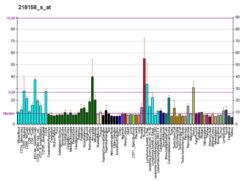APPL1
Adaptor protein, phosphotyrosine interacting with PH domain and leucine zipper 1 (APPL1), or DCC-interacting protein 13-alpha (DIP13alpha), is a protein that in humans is encoded by the APPL1 gene.[3][4][5]
The protein encoded by this gene has been shown to be involved in the regulation of cell proliferation, and in the crosstalk between the adiponectin signalling and insulin signalling pathways. The encoded protein binds many other proteins, including RAB5A, DCC, AKT2, PIK3CA, adiponectin receptors, and proteins of the NuRD/MeCP1 complex. This protein is found associated with endosomal membranes, but can be released by EGF and translocated to the nucleus.[5]
| Mouse Mutant Alleles for Appl1 | ||
|---|---|---|
| Marker Symbol for Mouse Gene. This symbol is assigned to the genomic locus by the MGI | Appl1 | |
| Mutant Mouse Embryonic Stem Cell Clones. These are the known targeted mutations for this gene in a mouse. | Appl1tm1a(KOMP)Wtsi | |
| Example structure of targeted conditional mutant allele for this gene | ||
Wtsi.jpg) | ||
| These Mutant ES Cells can be studied directly or used to generate mice with this gene knocked out. Study of these mice can shed light on the function of Appl1:
see Knockout mouse | ||
Interactions
APPL1 has been shown to interact with Deleted in Colorectal Cancer[6] and AKT2.[3]
References
- ↑ "Human PubMed Reference:".
- ↑ "Mouse PubMed Reference:".
- 1 2 Mitsuuchi Y, Johnson SW, Sonoda G, Tanno S, Golemis EA, Testa JR (Oct 1999). "Identification of a chromosome 3p14.3-21.1 gene, APPL, encoding an adaptor molecule that interacts with the oncoprotein-serine/threonine kinase AKT2". Oncogene. 18 (35): 4891–8. PMID 10490823. doi:10.1038/sj.onc.1203080.
- ↑ Nechamen CA, Thomas RM, Dias JA (Nov 2006). "APPL1, APPL2, Akt2 and FOXO1a interact with FSHR in a potential signaling complex". Mol Cell Endocrinol. 260-262: 93–9. PMC 1782224
 . PMID 17030088. doi:10.1016/j.mce.2006.08.014.
. PMID 17030088. doi:10.1016/j.mce.2006.08.014. - 1 2 "Entrez Gene: APPL1 adaptor protein, phosphotyrosine interaction, PH domain and leucine zipper containing 1".
- ↑ Liu, Jiayou; Yao Fayi; Wu Ruping; Morgan Michael; Thorburn Andrew; Finley Russell L; Chen Yong Q (Jul 2002). "Mediation of the DCC apoptotic signal by DIP13 alpha". J. Biol. Chem. United States. 277 (29): 26281–5. ISSN 0021-9258. PMID 12011067. doi:10.1074/jbc.M204679200.
External links
- Human APPL1 genome location and APPL1 gene details page in the UCSC Genome Browser.
Further reading
- Nakajima D, Okazaki N, Yamakawa H, et al. (2003). "Construction of expression-ready cDNA clones for KIAA genes: manual curation of 330 KIAA cDNA clones.". DNA Res. 9 (3): 99–106. PMID 12168954. doi:10.1093/dnares/9.3.99.
- Nagase T, Kikuno R, Ishikawa KI, et al. (2000). "Prediction of the coding sequences of unidentified human genes. XVI. The complete sequences of 150 new cDNA clones from brain which code for large proteins in vitro.". DNA Res. 7 (1): 65–73. PMID 10718198. doi:10.1093/dnares/7.1.65.
- Liu J, Yao F, Wu R, et al. (2002). "Mediation of the DCC apoptotic signal by DIP13 alpha.". J. Biol. Chem. 277 (29): 26281–5. PMID 12011067. doi:10.1074/jbc.M204679200.
- Strausberg RL, Feingold EA, Grouse LH, et al. (2003). "Generation and initial analysis of more than 15,000 full-length human and mouse cDNA sequences.". Proc. Natl. Acad. Sci. U.S.A. 99 (26): 16899–903. PMC 139241
 . PMID 12477932. doi:10.1073/pnas.242603899.
. PMID 12477932. doi:10.1073/pnas.242603899. - Yang L, Lin HK, Altuwaijri S, et al. (2003). "APPL suppresses androgen receptor transactivation via potentiating Akt activity.". J. Biol. Chem. 278 (19): 16820–7. PMID 12621049. doi:10.1074/jbc.M213163200.
- Miaczynska M, Christoforidis S, Giner A, et al. (2004). "APPL proteins link Rab5 to nuclear signal transduction via an endosomal compartment.". Cell. 116 (3): 445–56. PMID 15016378. doi:10.1016/S0092-8674(04)00117-5.
- Nechamen CA, Thomas RM, Cohen BD, et al. (2005). "Human follicle-stimulating hormone (FSH) receptor interacts with the adaptor protein APPL1 in HEK 293 cells: potential involvement of the PI3K pathway in FSH signaling.". Biol. Reprod. 71 (2): 629–36. PMID 15070827. doi:10.1095/biolreprod.103.025833.
- Beausoleil SA, Jedrychowski M, Schwartz D, et al. (2004). "Large-scale characterization of HeLa cell nuclear phosphoproteins.". Proc. Natl. Acad. Sci. U.S.A. 101 (33): 12130–5. PMC 514446
 . PMID 15302935. doi:10.1073/pnas.0404720101.
. PMID 15302935. doi:10.1073/pnas.0404720101. - Ballif BA, Villén J, Beausoleil SA, et al. (2005). "Phosphoproteomic analysis of the developing mouse brain.". Mol. Cell Proteomics. 3 (11): 1093–101. PMID 15345747. doi:10.1074/mcp.M400085-MCP200.
- Gerhard DS, Wagner L, Feingold EA, et al. (2004). "The status, quality, and expansion of the NIH full-length cDNA project: the Mammalian Gene Collection (MGC).". Genome Res. 14 (10B): 2121–7. PMC 528928
 . PMID 15489334. doi:10.1101/gr.2596504.
. PMID 15489334. doi:10.1101/gr.2596504. - Rual JF, Venkatesan K, Hao T, et al. (2005). "Towards a proteome-scale map of the human protein-protein interaction network.". Nature. 437 (7062): 1173–8. PMID 16189514. doi:10.1038/nature04209.
- Mao X, Kikani CK, Riojas RA, et al. (2006). "APPL1 binds to adiponectin receptors and mediates adiponectin signalling and function.". Nat. Cell Biol. 8 (5): 516–23. PMID 16622416. doi:10.1038/ncb1404.
- Cheng KK, Lam KS, Wang Y, et al. (2007). "Adiponectin-induced endothelial nitric oxide synthase activation and nitric oxide production are mediated by APPL1 in endothelial cells.". Diabetes. 56 (5): 1387–94. PMID 17287464. doi:10.2337/db06-1580.
- Li J, Mao X, Dong LQ, et al. (2007). "Crystal structures of the BAR-PH and PTB domains of human APPL1.". Structure. 15 (5): 525–33. PMID 17502098. doi:10.1016/j.str.2007.03.011.
- Zhu G, Chen J, Liu J, et al. (2007). "Structure of the APPL1 BAR-PH domain and characterization of its interaction with Rab5.". EMBO J. 26 (14): 3484–93. PMC 1933402
 . PMID 17581628. doi:10.1038/sj.emboj.7601771.
. PMID 17581628. doi:10.1038/sj.emboj.7601771. - Saito T, Jones CC, Huang S, et al. (2007). "The interaction of Akt with APPL1 is required for insulin-stimulated Glut4 translocation.". J. Biol. Chem. 282 (44): 32280–7. PMID 17848569. doi:10.1074/jbc.M704150200.



